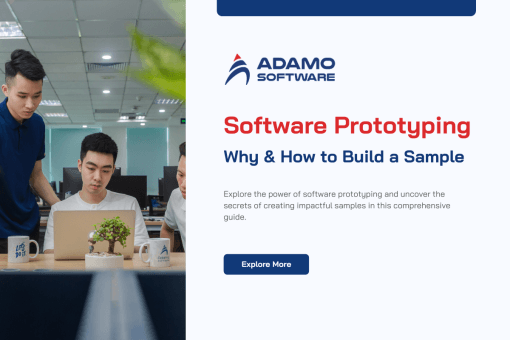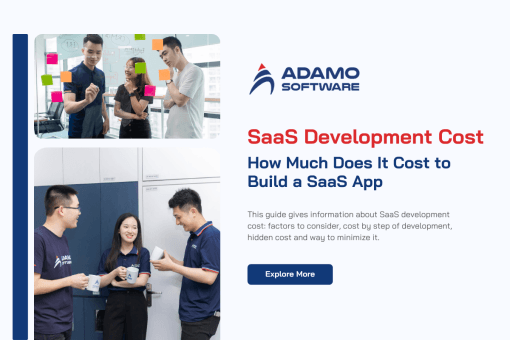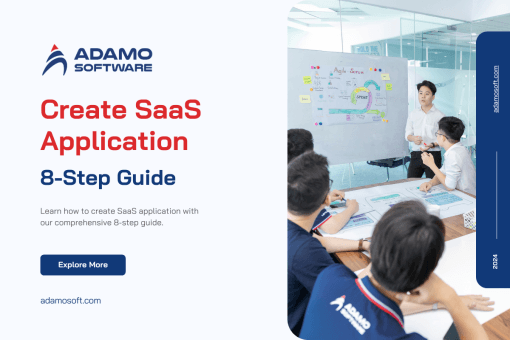SaaS Tech Stack to Build Your SaaS from Scratch 2024

Discover the ultimate SaaS tech stack for building your own SaaS platform from scratch in 2024, packed with cutting-edge tools, frameworks, and strategies to help you create a powerful and scalable SaaS solution that stands out in today’s competitive market
Nowadays, CTOs typically face the challenge of selecting the perfect tech stack for their SaaS applications. This is a vital part when developing a SaaS app as if your SaaS stack doesn’t scale, evolve, and continuously improve, you could end up needing to completely redo your web application every few years.
When looking at SaaS tech stack, you’ll often see questions about what makes the perfect choice. The quick answer is: a stack that includes the languages and tools to get the job done efficiently. However, some languages and tools can make your developers’ lives easier and reduce SaaS development costs.
Now, let’s start with the basic
I. What is SaaS Tech Stack
A SaaS tech stack is like a toolbox that developers use to build applications for the web or mobile. It’s made up of different technologies, programming languages, and tools.
It contains three main layers:
_ Frontend: It involves creating the parts of a website that users interact with, such as buttons, forms, menus, and other graphical elements.
_ Backend: This behind-the-scenes part handles user requests, manages data, and makes things happen.
_ Infrastructure: The foundation that supports the whole application, including servers, databases, and other technical stuff.
The choice of SaaS tech stack can have a big impact on how well the app performs, how easy it is to scale, and how secure it is. So it’s important to think carefully about what you need and what your team is good at.
II. Why Selecting the Right SaaS Tech Stack Is Important
In 2023, the SaaS market worldwide earned around $197 billion, which is about two-thirds of the total revenue from all public cloud services. Additionally, by 2025, it’s expected that 85% of business applications will be SaaS-based.
That’s why it’s essential to choose the right tech stack for your SaaS development if you want to stay competitive.
Furthermore, without exaggeration, every part of app development, performance, and maintenance, including budgeting, depends on the choices you make regarding your SaaS tech stack. Since a SaaS application is a complex product, let’s think about the different aspects of its creation and usage in the context of technology stack optimization.
III. Important Factors Affecting Choosing Best SaaS Tech Stack
One important thing to understand is that the tech tools you choose for your SaaS application will affect the cost of development. Using structured frameworks can boost productivity, minimize errors, and save on maintenance expenses.
Ultimately, the choice of tech tools depends on various factors, such as the size of your project and the level of security you require. To help you make informed decisions, we’ve gathered a list of the key factors to consider when selecting the best tech stack for SaaS applications in 2024.
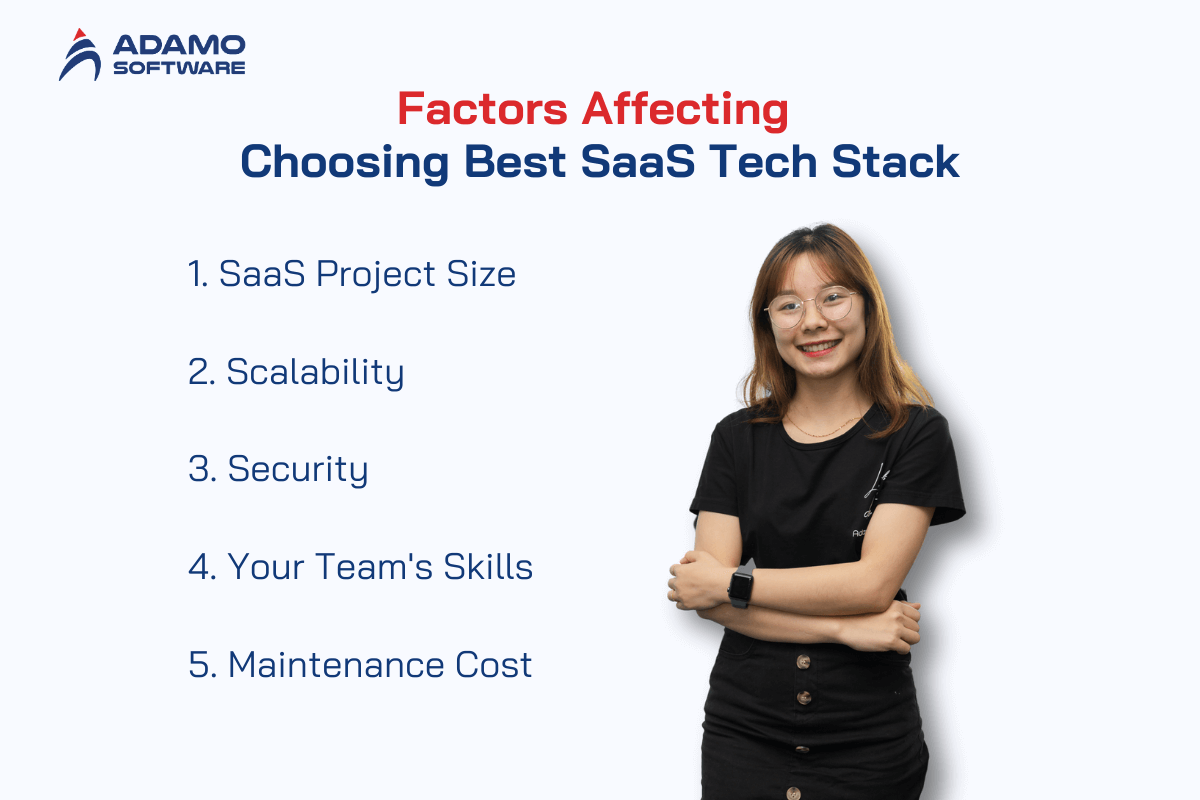
1. SaaS Project Size
The size of your project will greatly influence the tech stack you choose. Projects can be classified into three categories based on its scale
_ Small projects – These include blogs and presentations. You only need a single framework to get started.
_ Medium projects – These typically involve interactive web applications, such as online stores and banking apps. They require a multi-layered framework and interact with various APIs.
_ Large projects – These are very interactive and need multiple frameworks, coding languages, and software tools, with a strong focus on security. Examples include marketplaces and social media platforms.
2. Scalability
For your business to grow, your application needs to be scalable. This means it should be able to handle changes and integrate with other software as your business expands. Scalability comes in two forms: vertical (adding new, often more complex tasks) and horizontal (handling growth).
3. Security
Large and interactive applications must be secure, so users feel safe using them, especially for financial or shopping purposes. Your tech stack should include security measures like authorization algorithms, reliable servers, frequent backups, and restricted data access.
4. Your Team’s Skills
The tech stack you choose should align with your developers’ skills. So, before deciding which SaaS tech stack to use, evaluate your team’s skills (languages, frameworks, and tools that they are already familiar with).
This makes it easier to solve coding problems and reduces project completion time and costs.
5. Maintenance Cost
Maintenance costs are influenced by the coding language and architecture used.
If you want your SaaS application to last a long time, it’s important to choose a popular language and framework combination. While new tools come out often, it’s best to stick with ones that have a lot of people using and supporting them. This way, you won’t have to make a lot of big changes to your application later on.
A tip is using open-source software can significantly reduce these costs, as it allows for product reuse and improves consistency. Scalable architecture also simplifies maintenance.
You can gain more insights into How to Create SaaS Application in our dedicated blog
IV. SaaS Architecture: Single-tenant vs. Multi-tenant
There are two main types of SaaS architectures:
1. Single-tenant
How it works: One customer uses a separate instance of the software and infrastructure, without sharing with others.
Benefits:
_ Security: Since only one customer uses it, the system is more secure.
_ Reliability: The dedicated environment means plenty of resources and high availability.
_ Customization: You can tailor the system to fit your needs.
2. Multi-tenant
How it works: Multiple customers share one instance of the software and its infrastructure, but their data stays separate and private.
Benefits:
_ Cost-effective: Sharing reduces costs, which often leads to lower prices for you.
_ Integration: It’s easier to connect with other applications using APIs.
_ Maintenance-Free: The SaaS provider handles the maintenance, so you don’t have to worry about it.
V. Complete Guide to Choose the Right SaaS Tech Stack
If your SaaS company has a tech expert, you’re likely familiar with your technology stack. However, many SaaS entrepreneurs might only have a basic understanding of the technology involved. Here’s a simple overview of the main components of a SaaS technology stack:
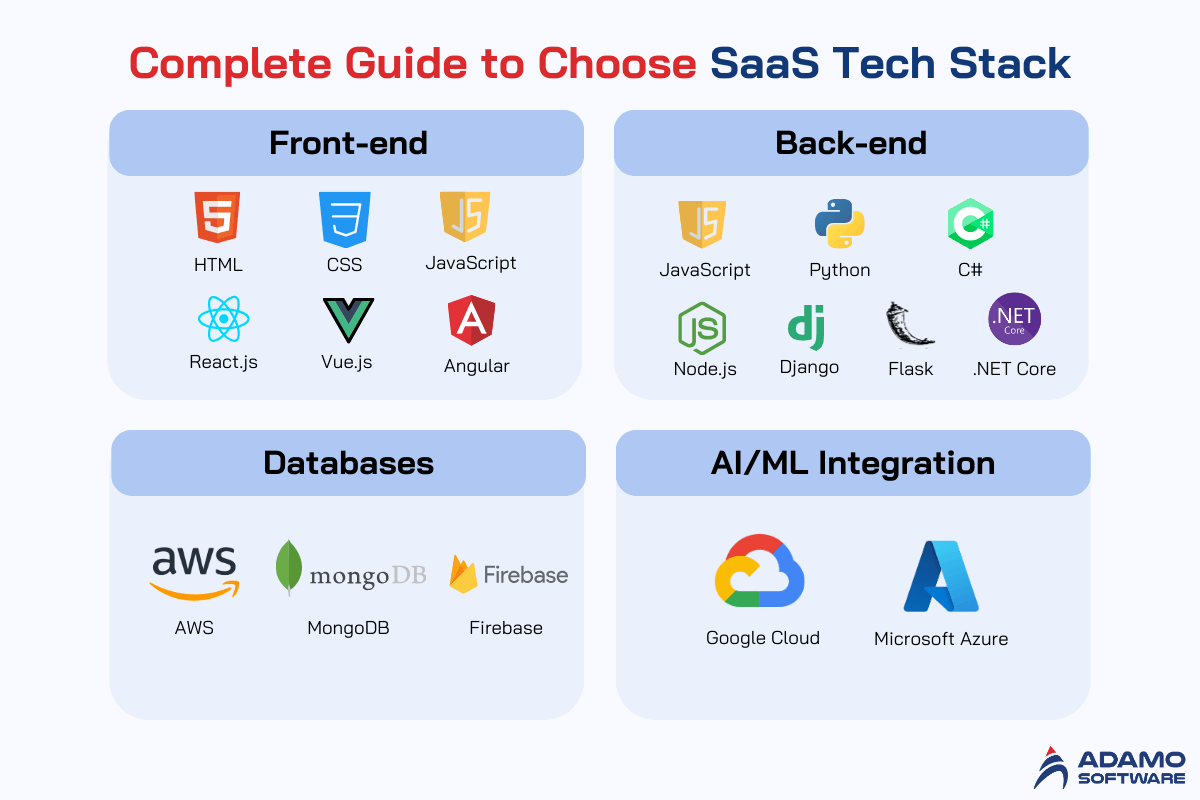
1. Front-end Tech Stack
This part includes everything users see and experience on a webpage: text, colors, styles, images, graphs, and more. The core technologies are HTML, CSS, and JavaScript/TypeScript, often enhanced with frameworks like React or Vue.js for better interactivity.
_ HTML: Think of HTML as the skeleton of a house. It’s a foundational markup language used to create and structure content on a webpage.
_ CSS: CSS is like the paint and decoration of the house. It controls the look of a webpage, including fonts, colors, and layouts. For more dynamic and manageable styles, developers use frameworks like SASS and LESS and methodologies like BEM (Block Element Modifier). CSS also ensures your web applications are mobile-friendly and accessible on all devices.
_ JavaScript: This is the electricity and automation system of the house, making it functional and interactive. JavaScript is a crucial programming language for adding interactivity to web pages. With frameworks like React, Angular, and Vue, developers can create rich, dynamic web experiences. TypeScript, a more structured version of JavaScript, is also becoming popular.
Frameworks:
_ React.js: A library that’s a standard for building interactive user interfaces. Using React with frameworks like Next.js can enhance performance and SEO through features like server-side rendering and static site generation.
_ Vue.js and Angular: These frameworks provide comprehensive solutions for building scalable and reactive web applications. Your choice should depend on your project’s needs and your team’s familiarity with the framework.
2. Back-end Tech Stack
The backbone of SaaS application is its backend, often called the server side of the tech stack. It’s like the backstage crew in a theater performance: while they may be unseen, their crucial roles ensure everything runs smoothly.
_ JavaScript (Node.js): Popular for its non-blocking, event-driven architecture, making it ideal for real-time applications.
_ Python: Known for its simplicity and readability, widely used with frameworks like Django and Flask that speed up development.
_ C#: Often overlooked, but when combined with .NET Core, it’s a powerful option for building modern, scalable web applications.
Frameworks:
_ Node.js: More than just a runtime environment, Node.js acts as a framework for building scalable server-side applications.
_ Django: Known for its “batteries-included” approach, providing many built-in features.
_ Flask: Appreciated for its simplicity and flexibility, allowing for quick and customizable development.
_ .NET Core (C#): A versatile and high-performance framework suitable for building a variety of applications.
3. Databases for SaaS Project
A database is simply a collection of information stored in an organized way. The type of database you choose depends on your industry. Generally, databases fall into two main categories:
_ Relational databases: These use a structured format to store data in tables and rows. They are ideal for data that fits neatly into a predefined template. Examples include PostgreSQL, Oracle, and MySQL.
_ Non-relational databases (NoSQL): These handle unstructured data that doesn’t fit into tables. For example, the data for a messaging app like Facebook Messenger is too variable for traditional SQL databases. NoSQL databases store data in formats like JSON documents, which are flexible and adaptable to various data types. They are also good for horizontal scaling.
Top Databases for SaaS Development in 2024
1. AWS (Amazon Web Services)
AWS is a comprehensive cloud computing platform offering IaaS, SaaS, and PaaS. It supports tight security and scalability, making it suitable for various applications.
Pros:
_ Easy to use
_ High security
_ Elastic load balancing
_ Speed and agility
Cons:
_ Security limitations
_ Additional technical support charges
_ Limitations of Amazon EC2
2. MongoDB
MongoDB is a popular NoSQL database that stores data in JSON-like documents. It is highly scalable and integrates well with AWS services.
Pros:
_ Scalability
_ High availability and durability
_ Security and compliance
_ No need for mapping application objects
Cons
_ No transaction support
_ Document size limits
_ High memory usage for data storage
3. Firebase
Firebase, developed by Google, is a Backend as a Service (BaaS) platform that offers various tools and services for building and growing apps. It stores data in JSON-like documents and is known for reducing development time.
Pros:
_ Excellent database capabilities
_ Free installation
_ Static hosting
_ Great documentation
_ Easy integration
_ Firebase analytics and testing services
_ Serverless applications
_ Machine learning capabilities
Cons:
_ Poor iOS support
_ Vendor lock-in issues
_ Limitations of Firebase real-time database
4. AI & ML Integration
Integrating AI and ML can provide in-depth data analytics for your SaaS. Services from AWS, Google Cloud, and Microsoft Azure offer built-in AI algorithms. Alternatively, you can use libraries from Python, R, or Go, though these require advanced tech skills.
VI. Expert Tips for Picking SaaS Technology Stack in 2024
_ Choose a SaaS tech stack your development team knows well. This helps you deliver the product faster and update or add new features quickly.
_ Add new features to production smoothly with minimal human effort and avoid errors. Use tools like Continuous Delivery DevOps for this.
_ Automate scaling and managing production and staging environments to reduce the need for manual work.
_ Ensure new team members get up to speed quickly so they can be productive in no time.
_ Check if the technology you pick has a stable future. Otherwise, you might need to replace it in a few years when its support ends.
VII. SaaS Application Development Trend 2024 and Beyond
It’s now 2024, and leaders are facing the challenge of managing tighter budgets while driving greater returns on investment with fewer resources. Here are three trends in SaaS application development for 2024 and beyond:
1. Low-Code Development
Developing software applications can be a lengthy process, but low-code development offers an easier way to create apps with minimal coding. Gartner’s research indicates that the adoption of low-code development will exceed 50% within a decade, as companies of all sizes embrace this approach.
So, how do we start with low-code development, and what can we achieve with it? Low-code development allows developers to quickly turn ideas into reality within a limited budget. These platforms function like purpose-built IDEs, designed with various tools to meet different needs.
Common use cases for low-code platforms:
_ Enhancing an existing SaaS infrastructure with custom features to meet specific business needs.
_ Transitioning from traditional spreadsheets to modern, web-hosted relational databases.
_ Modernizing legacy applications to improve maintainability and extend their lifespan.
_ Building complex applications from scratch more easily and quickly.
_Creating full-stack web applications with features like business intelligence and data visualization for an engaging user experience.
2. Python’s Growing Dominance in the Tech Industry
As ML and data science gain popularity, the demand for experienced Python developers is set to increase significantly. With over 700 programming languages available, businesses often struggle to choose the right one for their projects.
Python stands out as a dynamic language capable of handling various tasks, making it an ideal choice for complex jobs. Its versatility allows developers to tackle tasks ranging from website design to mobile app development and machine learning models efficiently. This versatility has made Python a favorite among SaaS tech stack.
3. React Native’s Continued Popular
React Native has become a powerful tool in the hybrid development market. Its ability to create high-quality, cross-platform applications with a single codebase has revolutionized app development for many developers and businesses.
As the go-to choice for hybrid development, React Native helps businesses maximize their reach in the global market. Its influence in the sector continues to grow, showing no signs of waning.
VIII. How Adamo Help You Build SaaS App with SaaS Tech Stack
Choosing the right technology stack for SaaS development can be complex, with many factors to consider. Planning ahead is crucial as it saves time and money and ensures the timely launch of your web application. You can either choose the best tech stack on your own or hire a software development company for assistance.
Adamo Software has extensive experience with various tech stacks across different industries such as Travel & hospitality, EdTech, Media & Entertainment and can handle your SaaS development and MVP tasks. You can also hire our dedicated team to bring your ideas, goals, and business requirements to life with our SaaS application development services.
If you need more guidance on selecting a SaaS tech stack or want to explore this topic further, Adamo is here to help. Contact us today to learn more about our services and how we can support you in this important decision-making process.







